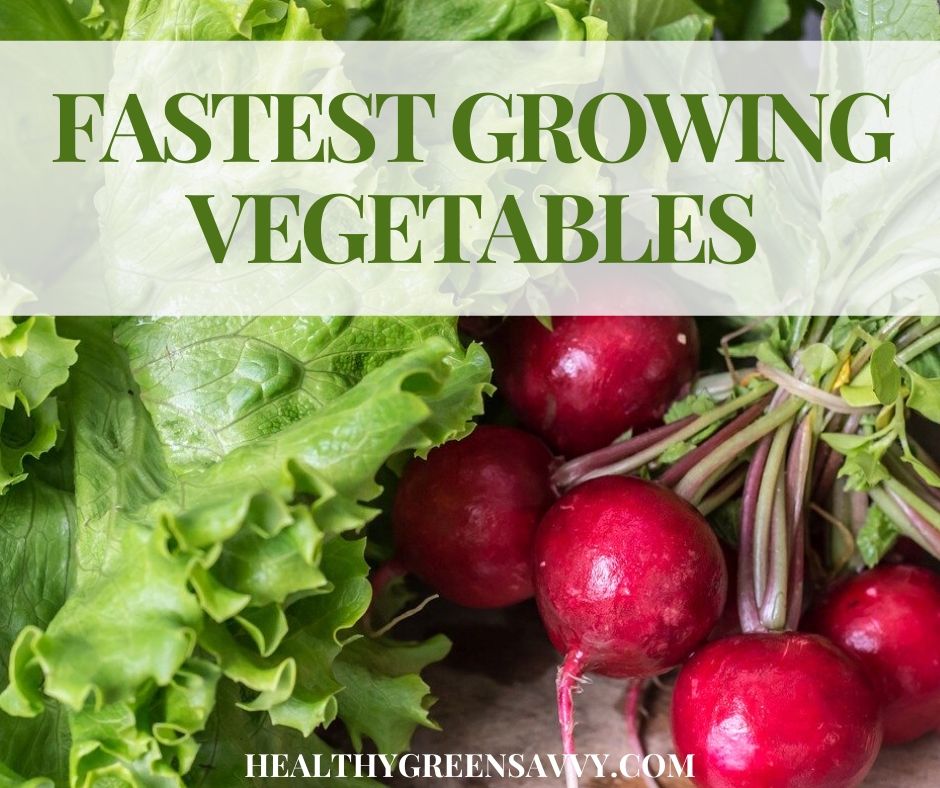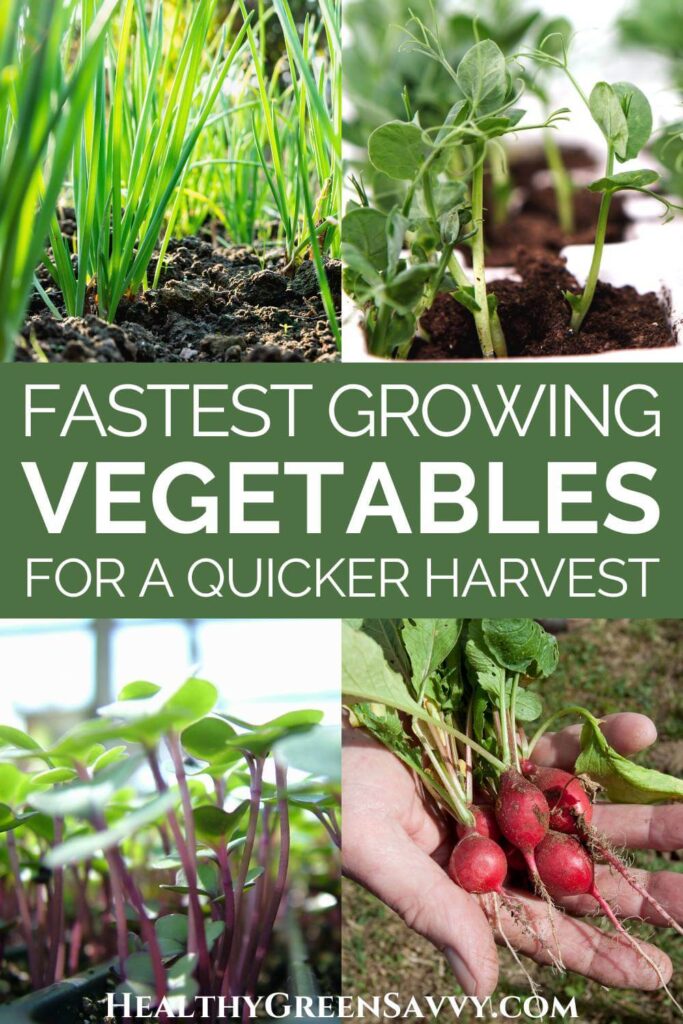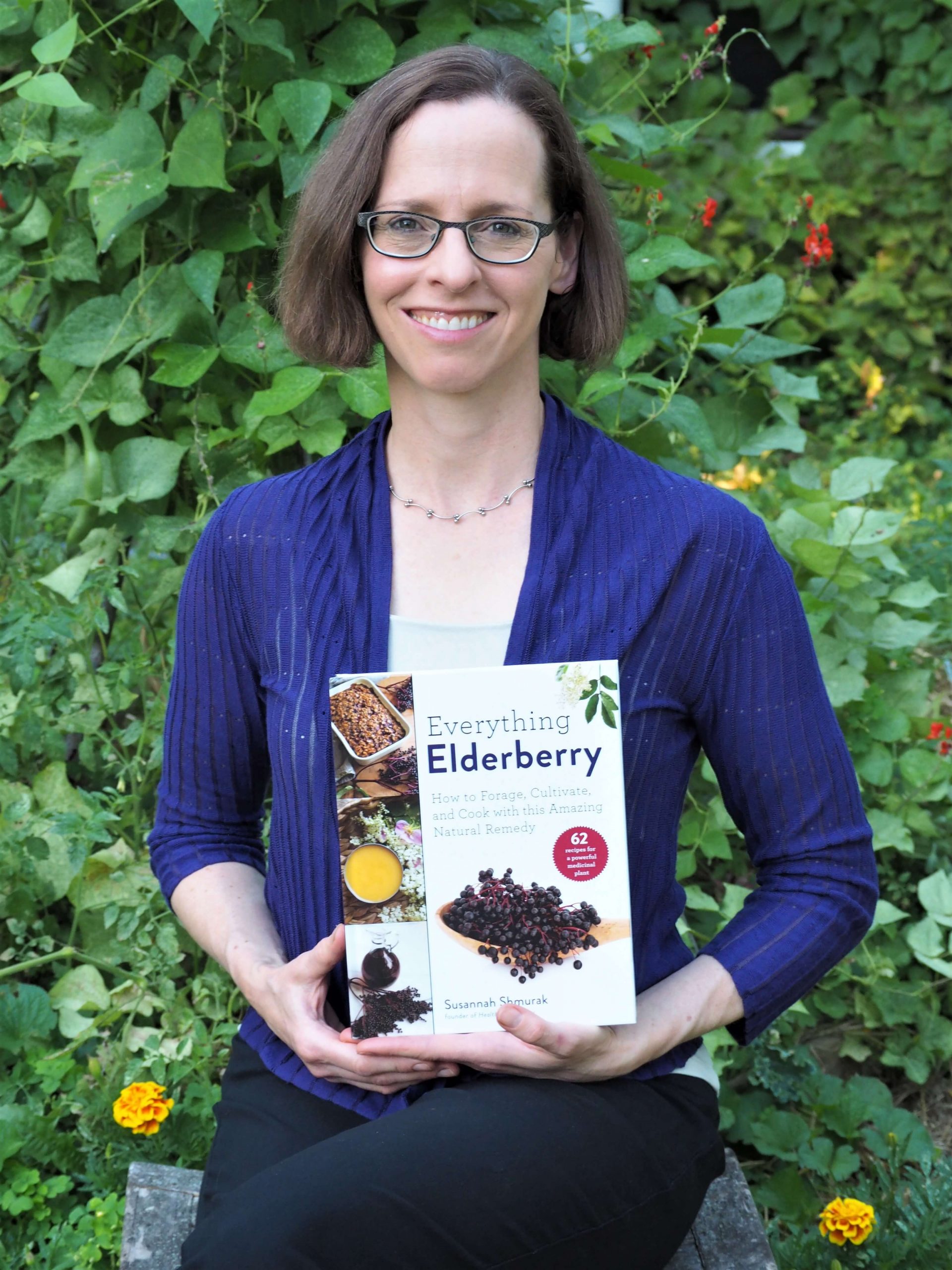Last Updated on July 25, 2024
Yearning for some homegrown goodness ASAP? Plant some of the fastest growing vegetables and enjoy harvesting them in as little as 2 weeks. Here are 23 vegetables that grow fast so you can enjoy garden goodness SOON!
Whether you’re reading this in early spring or it’s well into summer and you’re wondering if it’s too late to plant, there are plenty of options for fast growing vegetables to consider planting today.

WHICH ARE THE FASTEST GROWING VEGETABLES?
Some garden veggies take months to reach maturity, while other vegetables grow very quickly. While you may have to wait up to 100 days for your sweet potatoes or melons, quick-growing crops like salad greens can be ready in under a month, even less if you pick them at the “baby” stage. Some fast growing vegetables take only a little bit longer.
SELECTING FAST GROWING VEGETABLES
When you’re reading seed packets or information in catalogs, look for what it says about “days to maturity.” Some categories of vegetables just naturally take longer, as they have large fruits to produce, as opposed to some quick-growing greens, where what you harvest is the leaves.
Even within categories, you might find quite a bit of variation. Many varieties have been bred to mature more quickly, and will often have “early” in their name. One variety may take fewer than 60 days while another may take over 75.
Look carefully at what different varieties of vegetables you’re considering say for days to maturity and choose the one with the lowest number for the quickest harvest.
You can find seeds for these fast growing veggies at most garden centers and online from your favorite seed supplier. High Mowing Seeds, Botanical Interests, Eden Brothers, True Leaf Market, and Seeds Now carry many of them.
Compact varieties often yield earlier their bigger cousins. If you see the word ‘bush’ in the name, it means the plant will stay small rather than expend energy growing enormous. In general, bush varieties will reach maturity sooner.
You’ll commonly find bush beans, which yield more quickly than their climbing (pole bean) counterparts. I’ve grown zucchini labeled ‘bush’ as well. The smaller size is helpful for our not-so-big growing space. You may get a smaller yield from each plant, but you’ll get to harvest sooner.
SPEEDING UP YOUR FAST GROWING VEGETABLES
If you want your veggies even quicker, you might consider these ways to harvest fresh produce in as little as 3 days!
Pick at the ‘Baby’ Stage
Though you’ll get bigger yields overall if you let your crops reach their full size, picking your greens and roots before they get all the way to maturity lets you enjoy them sooner. Plant your greens thickly and harvest them early, and you could be enjoying homegrown salads in a matter of weeks. Baby greens take only two weeks while root veggies like radishes and beets can be harvested at the baby stage in about three weeks.
Consider Microgreens or Sprouts
Microgreens are harvested at an even earlier stage than ‘baby’ greens, and can be ready in as little as 10 days. Sprouts (like alfalfa) can take as little as 3 or 4.
Broccoli sprouts are reported to be especially nutritious, and there are many more options for seed sprouting. Learning to sprout seeds is a great way project for winter, when there’s nothing growing in the garden. Here’s information on sprouting seeds from Garden Therapy.
You can find loads of options for microgreens at True Leaf Market.
TIPS FOR GETTING FAST GROWING VEGETABLES EVEN FASTER
There are a few things you can do to help your crops mature more quickly, especially in early spring when cooler temperatures slow growth.
1. Warm your soil at the beginning of the season
To help get a jump on your growing season, you can speed the warming of your soil by pulling away mulch and putting black plastic over your growing area. The plastic will help trap heat and warm up the soil. Raised beds will warm faster than garden soil.
2. Choose a Full Sun Location
Plants will grow more quickly — and typically yield more — in full sun, though if you live somewhere that gets really hot in summer, you need to plan for those crops that can’t handle the heat. Spinach and lettuce for instance, bolt and become bitter when it gets too hot, so plant those early and provide some shade if you’re going to try growing them in summer. If you have less than 6 hours of sun, you’ll want to focus on vegetables that grow in shade.
3. Water Consistently
You want your seeds to germinate, so keeping them moist until they sprout is critical. If you forget to keep your newly-sown seeds watered, you may delay germination or not get any at all and have to replant. Larger seeds benefit from soaking overnight, which helps to break dormancy more quickly than if you rely on moist soil to get things going.
As plants grow, consistent watering will help them reach maturity more quickly and prevent plant stress. Plants that don’t get enough water are also more prone to pests and disease, and crops like cucumbers will be more bitter if they don’t receive enough water.
4. Plant in Healthy Soil and Mulch Well
No plants grow well in soil that’s low in nutrients and organic matter. If you have very sandy or clay soil, you’ll need to amend it with plenty of compost to give your plants what they need to thrive. Mulch well to protect your soil, retain moisture, and keep out weed competition.
5. Consider Perennial Food Plants
I highly recommend planting some perennial vegetables (or learning about the ones you’re already growing, like Virginia waterleaf, purslane, and dandelions), so you can harvest delicious food from your yard as soon as things start poking out of the ground in spring. While I wait for my first arugula and lettuce to sprout, our chives and many perennial greens are already ready to harvest. Rhubarb and edible violet flowers aren’t far behind.
While perennials do take awhile to get established, they can wind up being quicker than crops you plant each year once they take off. Especially for the distracted or overstretched gardener, not having to think about getting the soil ready, sowing seeds, and keeping them watered — something I often struggle with in unpredictable northern springs — makes garden success far more likely. Check out the perennial veggie options so even if your earliest crops don’t succeed, you still have some yummy stuff to harvest.
Learning about which weeds are edible will also let you harvest something from your garden while you wait for your veggies to take off. There are also more than 150 flowers you can eat worth getting to know, as you’re likely already growing many of them.
If you don’t have a garden yet, here’s what to know about starting a garden from scratch. You can also plant a lot of these vegetables that grow fast in pots, indoors or out.
Now, onto the list of fastest growing vegetables!
FASTEST GROWING VEGETABLES LIST
VEGETABLES READY IN A MONTH OR LESS
GREENS

Greens like lettuce, spinach, and other salad greens can be ready for harvest at the baby stage in just a few weeks. Plant a variety and enjoy vibrant fresh salads straight from the garden.
Lettuces
When selecting lettuce seeds, choose leaf lettuce (like oakleaf or salad bowl), which will be ready for harvest well before head lettuce. You pick a few leaves from many plants, and they keep producing more for you.
I like lettuce mixes so you only have to buy one packet. These mesclun greens can be harvested at the baby stage starting just two weeks from sowing.
Consider some cold-hardy varieties like miner’s lettuce (Claytonia) and mâche, so you can continue enjoying fresh salads from your garden long after the frost has zapped your more tender greens.
Arugula
Also known as rocket, arugula is a mildly bitter green that’s fantastic in salads or on pizza. Some varieties may be harvested at the baby stage in as little as two weeks. I’m trying a perennial variety called Turkish rocket this year (hardy to zone 4; other perennial types are hardy to zone 6) but I grow some annual arugula every year.
While you’re waiting for your arugula to mature, harvest some dandelion greens — they’re a deliciously bitter green as well.
Here are more than 20 additional wild greens you might find growing in your garden or neighborhood.
Mustards
These spicy greens liven up salads and sandwiches. Try this variety pack of baby mustard greens, which can be picked in under four weeks.
Totsoi
Very cold tolerant, totsoi can be used raw or cooked. Totsoi may be harvested immature in under a month or at full size in about six weeks.
Spinach
Spinach may be harvested at the baby stage in as little as 3 weeks depending on the variety you choose. Here’s more info on how to grow spinach. Many of these fast-growing vegetables also make good companion plants for spinach to help you grow more in less space.
Chard or Silverbeet
Unlike spinach, chard can tolerate heat, making it a good choice for cooking greens. It’s also gorgeous, coming in eye-catching colors like orange, red, and yellow, which make it an excellent addition to an ornamental planting.
Chard can be picked at the baby stage for salads or allowed to mature for large leaves that can be used anywhere you’d like cooked spinach. I use the leaves in ratatouille and soups.
The stems are like a second vegetable that work well in soup or as pickles. (You’ll find a recipe for chard stem pickles in this post on root to stem eating.) Matures in 50-60 days.
Pea Shoots

While you have to wait close to two months for peas, pea shoots are ready to harvest in just 10 days! These tender tips have the sweet flavor of peas and are a delicious addition to salads, sandwiches, stirfries, soups, or smoothies.
Bok Choy/Pak Choi
The succulent stems of bok choy are a staple of stir-fries and Asian soups. A miniature version called Toy Choy matures in just a month.
ROOTS
Radishes
One of the fastest growing vegetables that you can plant when temperatures are still cool, some radishes may be picked small in as little as three weeks. The cherry belle radish reaches full size in just 25 days.
Salad Turnips
A little like a radish, these tender white salad turnips have a lot less kick to them, even a little sweetness. Many of us who aren’t big radish fans absolutely adore these juicy salad turnips, and they’re ready in about a month. We nibble them whole or slice them into salads. You can buy them here.
Mini Carrots
While full-size carrots can take longer, carrots that grow only a few inches long are ready in a month. Don’t forget to eat the tasty carrot tops as well.
Beets
Beets can be harvested at the baby stage. Like carrots, beets offer us a bonus crop, as we can harvest their greens as well as the sweet root.
VEGETABLES READY IN TWO MONTHS OR LESS
Scallions
Scallions grow from seed in about two months, but if you treat them right, you can harvest scallions far sooner. Harvest by cutting off the tops and leave the root in the ground, where it will regrow. You can harvest it again when the shoot is six inches.
Broccoli
Some varieties of broccoli mature in as little as two months. Di Cicco broccoli takes only 58 days.
Broccoli Raab
Also called broccolini or brocceletti, broccoli raab makes a tasty side dish or addition to stir fries. Matures in 45 days.
Peas
Snap peas are a garden favorite, and snow peas are wonderful in stirfries or sauteed on their own with a little sesame oil. If you haven’t grown your own snap or snow peas before, you’ll be stunned at how much better they taste than anything you can buy at the grocery store.
Choose a shorter variety for a quicker harvest, like Cascadian snap peas, which reach maturity in under two months. Peas are a cool-season crop, so get them in the ground as soon as your soil has thawed in spring for the earliest possible harvest.
Beans
Green (and purple and yellow) beans can mature in under two months. ‘Contender‘ is one of the faster maturing varieties, beginning to produce after only 50 days. This gorgeous purple bean is ready in about 55 days.
Zucchini and Summer Squash
Many summer squashes are ready to pick in about 50 days. This variety of yellow summer squash matures in just six weeks. If you prefer zucchini, look for more compact varieties. ‘Emerald Delight‘ matures in 50 days.
With some precautions you can avoid the dreaded squash vine borer and get a bumper harvest and try many of these creative and delicious zucchini recipes!
Okra
While not everyone likes okra, it’s among the fast growing vegetables to consider for your garden. This gorgeous red variety matures in under two months.
Napa Cabbage
Napa cabbage has a milder flavor than other cabbage and matures in just 50 days.
Kale
Fantastic in all sorts of recipes (check out this collection of healthy kale recipes), kale also makes utterly addictive baked kale chips.
Kale takes a bit longer to mature than more tender greens, but it can produce throughout the summer and is very cold-hardy, surviving long after your lettuce has frozen to mush. We often harvest our kale in snow. Baby kale can be harvested in three weeks, and fully mature kale takes closer to two months.
What are your favorite fast growing vegetables?
Pin to save these fastest growing vegetables for later!

Fastest growing vegetables photo credits: Christo Anestev, Thomas B., jacqueline macou

Susannah is a proud garden geek and energy nerd who loves healthy food and natural remedies. Her work has appeared in Mother Earth Living, Ensia, Northern Gardener, Sierra, and on numerous websites. Her first book, Everything Elderberry, released in September 2020 and has been a #1 new release in holistic medicine, naturopathy, herb gardening, and other categories. Find out more and grab your copy here.





 Hi, I'm Susannah, a garden geek, energy nerd, and fan of healthy food and natural remedies. Need some simple, practical solutions for living healthier and greener? You've come to the right place! More about me and my green projects
Hi, I'm Susannah, a garden geek, energy nerd, and fan of healthy food and natural remedies. Need some simple, practical solutions for living healthier and greener? You've come to the right place! More about me and my green projects